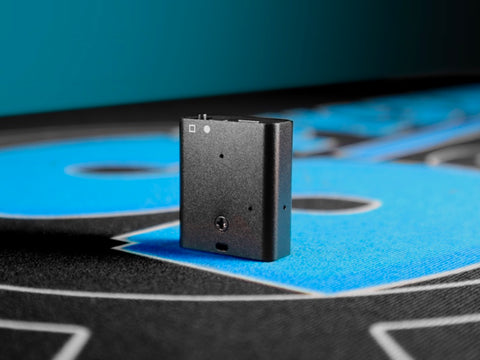WHAT IS A "BUG"?
In spy terms, a bug is a hidden surveillance device that picks up audio signals in targeted spaces. Have you ever heard the phrase "a fly on the wall?" Same concept, but even more discrete.
You may have seen movie characters searching their rooms for little devices easily found in lamps or around a picture frame. It makes for a fun scene, but listening devices are a little more covert than that.
With the right kind of device, you can place a bug inside virtually anything. From a telephone to a window frame, nothing is exempt.
Many people install an audio jammer or purchase bug sweepers to keep on hand. This bug sweeper, for example, covers a wide range of frequencies that could be transmitted. It's wireless and easy to use whenever you feel so inclined, especially for finding bugs in the office or home.
TYPES OF LISTENING DEVICES
RF TRANSMITTER
A radio frequency (RF) transmitter is a fancy little listening device that is virtually impossible to detect unless you know you're looking for it. It requires two pieces, which are the transmitter and the receiver. All you have to do to listen to people talking inside the room is pick up your receiver within the allotted range.
One of the most infamous examples of using an RF bug is the “Great Seal Bug” story. In 1952 an RF listening device was found in the carved wooden seal that had been presented to the US Embassy in Moscow in 1946.
As evidence of this story, RF transmitters are incredibly small and can be hidden within just about anything. Nearly all spying devices give off radio frequencies, but a lot of them transmit on frequencies that require specialized equipment to detect.
CELL PHONE
Phones can be programmed to make zero sounds or vibrations when called and then auto-answer to hear conversations around the mobile phone.
This bug can be created with a target phone, which is programmed and left somewhere until needed. An email or text can be sent to a person's phone containing the necessary software to be downloaded without consent or knowledge of the attack, turning the phone into a transmitter for private conversations. The limit to this kind of bug is the battery life.
To help prevent this from happening to you, take care when downloading apps onto your phone. It is easy enough to include harmful software in innocent-looking apps. Also, be wary of public WIFI connections. Public connections often mean someone could see what you're doing on your phone.
GSM BUG
GSM bugs basically work the same way as mobile phones. You can dial it up from anywhere in the world and listen in on the room conversation.
These kinds of devices are either a little black box that is hidden discreetly in the room, or they are designed to look like a device that you would normally find in an office or home, for example. It can be disguised as an unassuming phone charger, power strip, PC mouse, etc. Though it may look like a standard piece of equipment, a little listening device is installed, just waiting for action.

FACTORS TO CONSIDER WHEN YOU BUG A ROOM
TIME
How much time do you have on your hands? How quickly do you need the information?
These are questions that should be considered when bugging a room. In the case of any field agent, if the need is immediate, the agent will have to plant the bug themselves. If it's less urgent, they can call in a team and have a spotless, undetectable job done.
Agents are trained to plant a bug, but time constraints could make the job hastier than they would like. It might mean that the bug is in a vulnerable position or a spot, making it a little harder to hear conversation throughout the room.
Having plenty of time when planting bugs is always best, but rush jobs are sometimes necessary for the espionage game.

This fully functioning USB Drive has a voice-activated microphone and can be used as an audio bug. The only difference is this device would need to be retrieved from its location as it does not transmit wirelessly. However, some areas are easily accessible on a day-to-day basis making these types of spy voice recorders handy.
LOCATION
All hidden wireless bugs have ranges. The range can make a bug tricky to monitor because the bug also has to be in a place where the suspect will talk.
The surveillance team needs to be able to set up relatively close to the bug. That could mean the apartment next door, or it could mean the building across the street. That's part of why you never see the bad guy's club being the place that's bugged. The team can't hang out very well for endless hours monitoring from a table.
Certain listening devices record and store information until a receiver comes in range. With these kinds of bugs, all it takes is a driveby to pick up hours of surveillance. The upside is that the team can sit in cars and move with the device or have a quick getaway if something goes South.

Something as small and unimpressive-looking as the Magnetic Mini Voice Recorder is exactly what’s needed for bugging a room. It’s the size of a quarter, and nothing about it is eye-catching. The sleek, black square that it is flies completely under every radar.
While it looks unimpressive, it is anything but. This device can pick up audio more than 30 feet away, covering most, if not all, of the rooms you’re considering keeping tabs on. It will record continuously for over a day with just a 1-hour charge and can be stuck on anything metal, making it the perfect covert recorder!
It will store up to 288 hours of audio and is easily accessible without complex cords and software. Whether having guests over or monitoring a roommate, the Mini Voice Recorder will meet all your recording needs without drawing attention to you or itself.
POWER SOURCE
How long do you need the device to last? If it's a terribly long time, you will want to rely on something other than battery life. With today's technology, bugs can be planted directly into the target's electrical system giving them unlimited power. Of course, this type of installation also requires more time than planting a battery-powered device.
Some options have quite a bit of storage and battery life. For example, the USB Power Bank Audio Recorder has a 336-hour battery life or 150-days in voice-activation mode and can hold up to 576 hours of audio and has a handy magnet allowing you to attach it to a metal surface.

HOW AUDIO JAMMERS BLOCK LISTENING DEVICES
Audio jammers are small and usually mobile. Their purpose is to disrupt a microphone's ability to capture sound waves.
They do this by emitting white noise. When someone says "white noise," most people tend to think of static coming from an old TV, which is a good example. White noise is a steady stream of noise emitted at multiple frequencies. This kind of noise disrupts the small diaphragm in every listening device, which vibrates when sound waves hit it.
When the diaphragm is overloaded with white noise from an audio jammer, other sound waves, such as conversation, are lost in the vibration. It's not impossible to pick out voices surrounded by white noise, but it is very difficult.
Ways to maximize your audio jammer include speaking softly, moving closer to the audio jammer, and turning up the volume on the audio jammer. All these things can help distort voices even more.
You can also block sound waves. We've talked about your phone monitoring conversations. If you need to have a private conversation, you can place your phone inside your microwave. The design of the microwave will block any signals coming to and going from the phone. To test if your microwave is secure or not, place your phone inside the microwave and have some other mobile phone call yours. If your phone rings, it's not secure.
We also offer the Block It Pocket, which is much smaller than a microwave and is a portable bag that allows you to cut your phone off from wireless signals within seconds by just dropping the phone into the bag and sealing it. The RF signal-stopping bag does just that, and it works by incorporating blocking materials like pure silver, copper, stainless steel, and nickel into a high-quality fabric. This results in the 100+ dB blocking while inside the sealed bag.
- See All Of Our Spy Gadgets
- Shop Bug Detectors and Counter Surveillance - Click Here
- Shop Covert Voice Recorders - Click Here
- Read more Secure Zone blogs - Click Here

